|
AND IT'S SIBLING THE RODGERS AND SPENCER PERCUSSION ARMY REVOLVER
|
|
|
|
|
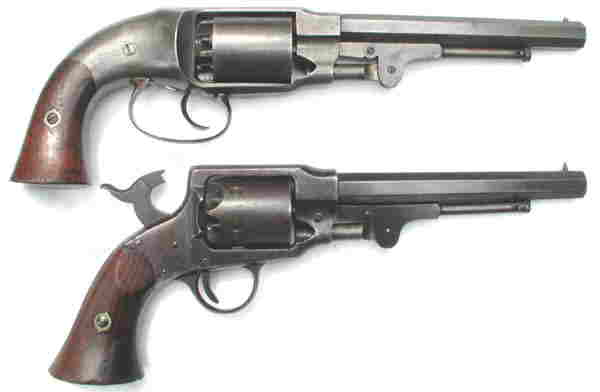
TOP: THE PETTENGILL .44 CALIBER DOUBLE ACTION PERCUSSION ARMY REVOLVER BOTTOM: THE RODGERS AND SPENCER .44 CALIBER SINGLE ACTION PERCUSSION ARMY REVOLVER
|
|
|
|
|
|
THE PETTENGILL PERCUSSION ARMY REVOLVER
|
|
|
On June 27, 1862, Edgar A. Raymond
and Charles Robitaille entered into a contract with the federal government
for 2,000 of their somewhat unusual revolver at price of $20.00 each.
An earlier contract for 5,000 of them had previously been canceled
by the Ordnance Department. It's pepperbox mechanism had been patented
by C.S. Pettengill of New Haven, Connecticut on July 22, 1856. It
was improved by a patent on July 27, 1858 submitted by Edgar A. Raymond
and Charles Robitaille of Brooklyn, New York and by a later patent
by Henry F. Rodgers of Willow Vale, New York on November 4, 1862.
The revolver was manufactured by Rodgers, Spencer & Company at
their Willow Vale facilities. It preceded the Rodgers and Spencer
revolver by over two years which utilized the basic frame front, loading
lever assembly and barrel design of it's predecessor and sibling,
the Pettengill revolver of the type featured in this posting. It was
basically a weapon designed by committee and was to suffer the same
fate as many items so brought to production. It appears that there
were just too many cooks involved in the design and production of
this arm.
|
|

|
|
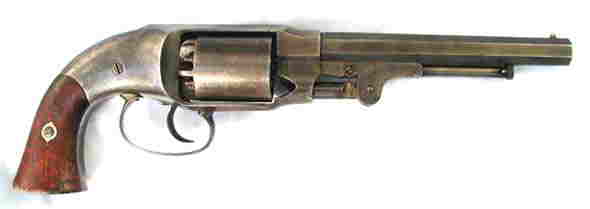
LEFT & RIGHT SIDE VIEWS OF THE PETTENGILL .44 CALIBER DOUBLE ACTION PERCUSSION ARMY REVOLVER
|
|
|
A total of 1,500 Pettengill Army revolvers
were delivered in 1862 with another 501 being delivered in early 1863
making a total of 2,001 received by the government during the six
months before mid January of 1863. However, existing serial
numbers, ranging from 1600 to 4600, would indicate that about 3,000
were actually produced. The serial number on the government inspected
arm featured in this posting is 4307. Many of these arms were issued
to the Army of the Mississippi under General William S. Rosencrans
and other Federal troops in the West. They very likely were used at
the Battle of Perryville, Kentucky in 1862 and although a failure
in the field and officially "discarded", many undoubtedly served through
the war or at least until the user thereof could replace it with a
more efficient side arm. It's front end design was later incorporated
into the Rodgers & Spencer .44 cal. single action revolver, which,
although the better of the two arms, arrived too late for service
in the war.
|
|
|
|
|
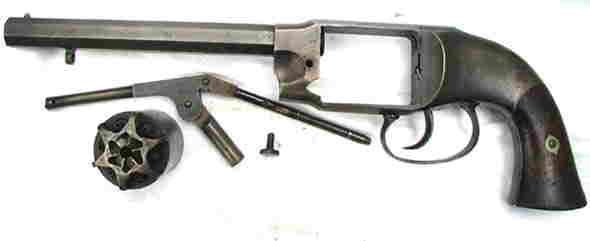
LEFT SIDE VIEW OF THE PETTENGILL ARMY REVOLVER WITH THE COMBINATION LOADING LEVER / CYLINDER ARBOR MECHANISM, THUMB SCREW AND CYLINDER REMOVED
|
|
|
This double action or "self cocking"
six-shot concealed hammer weapon is .44 caliber and weighs 3 pounds.
The 7-1/2" barrel is rifled with 6 grooves. Measured diagonally from
the tip of the butt to the muzzle face it is 14-11/16" overall. The
barrel is unmarked except for the government sub inspector's marking
of "WW" on the left flat just forward of the frame. The "WW"
stampings are those of William Walters, Armory Sub Inspector, 1862-1864.
The same "WW" stampings are also found on the left side of the frame
above the 7/16" diameter thumb screw and at the rear of the cylinder
just forward of a nipple well. A single "W" is also stamped on the
left side of the combination loading lever and cylinder arbor mechanism.
Frame markings also include "PETTENGILLS / PATENT 1856" which is stamped
in two lines on the top strap to the right of the sight groove and
the two line stamping of "PATD JULY 22 1856/ &
JULY 27 1858" stamped on the top strap to the left of the sight groove.
Additionally, the bottom of the frame bears the stamping of a non
factory deeply incised "X" forward of the normal two line stamping
of "PATENTED / NOV. 4, 1862". It should be noted that earlier production
arms were stamped"RAYMOND & ROBITAILLE / PATENTED 1858" on the
top strap to the left of the sight groove and that some specimens
may also have had "PETTENGILLS PATENT" stamped on the barrel. Other
markings on this arm include the serial number "4307" which is stamped
on the cylinder, the butt strap and inside of both grips. The cartouche
of the inspector's initials is also stamped in the left grip. It is
very difficult to read but may be "CGC" for Charles G. Chandler, Armory
Sub Inspector, 1861-1863.
|
|
 |
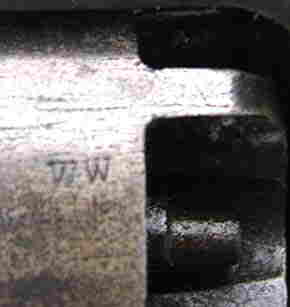 |
|
|
|

"W" STAMPING ON SIDE OF COMBO LOADING LEVER / CYLINDER ARBOR
|

CYLINDER SERIAL NUMBER STAMPING "4307" & "PETTENGILLS PATENT 1856" TOP RIGHT FRAME STAMPING
|
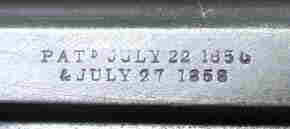
"PATD JULY 22 1856 & JULY 27 1858" TOP LEFT FRAME STAMPING
|

INCISED "X" & "PATENTED NOV. 4, 1862" STAMPING
|
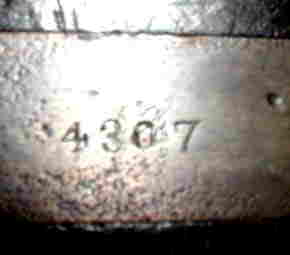
SERIAL NUMBER STAMPING "4307" - BUTT STRAP
|

LEFT GRIP CARTOUCHE "CGC"(?)
|
|
|
|
|
There is a brass cone front sight, set on center, 3/8" from the muzzle
face. The top of the frame is grooved and provides a "V" rear sighting
base. The malleable iron blued frame is rounded behind the cylinder.
A slight flaring of the metal provides a rather thin recoil shield
on both sides of the frame. A cone shaped loading groove that passes
entirely through the frame is wider on the right side than the left.
Loosening of the frame screw on the right side allows for removal
of the left rear frame plate and access to the "L" shaped hammer concealed
therein. A pull of the trigger revolves the cylinder, fires the weapon,
and cocks the hammer for the next shot. This unusual weapon was the
only American martial revolver of the Civil War made with an internal
hammer. Due to the delicate internal mechanism this arm, as previously
mentioned, proved a failure in the field and was replaced with more
substantial side arms such as the Remington and Starr revolvers. The
six-shot blued cylinder is 2-1/4" long. The nipples are recessed in
open, separately partitioned, wells. The case-hardened loading lever
has a plunger type latch that is held by a catch mortised into the
bottom of the barrel 1-1/2" from the muzzle. The large sweeping oval
trigger guard is blued as are the grip straps that are integral with
the frame. The black walnut two piece grips are oil finished
with the inspector's cartouche being stamped into the left grip.
It should be noted that the arms made for civilian use have varnished
grips.
|
|
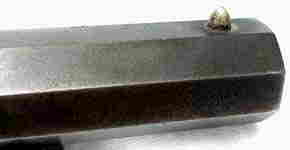
FRONT CONE SIGHT
|

TOP SIGHTING GROOVE
|
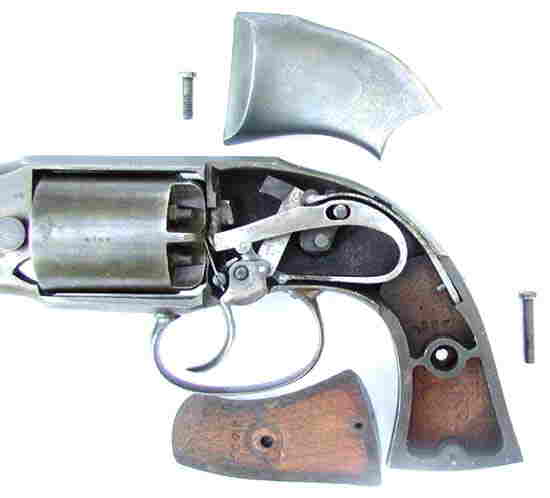
INTERNAL MECHANISM (NOTE SERIAL NUMBER "4307" INSIDE GRIPS)
|
|
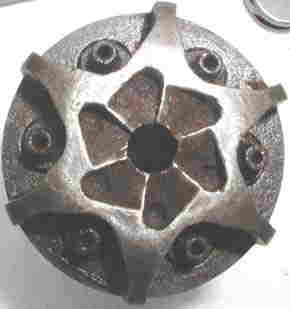
REAR CYLINDER VIEW
|
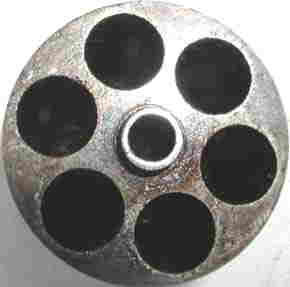
FRONT CYLINDER VIEW
|
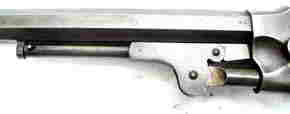 |
 |
|
|
|

SIDE VIEW OF COMBO RAM ROD & CYLINDER ARBOR
|
TOP VIEW OF COMBO RAM ROD & CYLINDER ARBOR (NOTE LACK OF SERIAL NUMBER)
|

THUMB SCREW (ALLOWS REMOVAL OF COMBO RAM ROD & CYLINDER ARBOR)
|
|
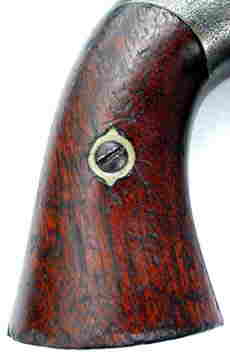 |
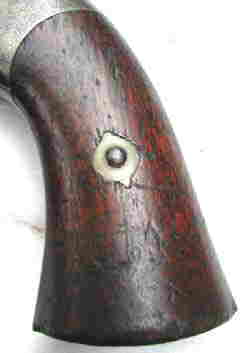 |
|
|
|

|
|

TOP & BOTTOM OVERALL VIEWS
|
|
|
|
|
|
The next posting, Part 2 of 2 of this series, will feature
the theRogers And Spencer .44 Caliber Single Action Percussion
Army Revolver, which is a sibling to the Pettengill revolver featured
in this posting. The familyresemblance is noticeable due to a very
similar front end.
|
|
|
Reference material for this posting came from "U.S. Military
Small Arms 1816-1865" by Robert M. Reilly, "Civil War
Small Arms", an American Rifleman Reprint - Articles "Civil
War Revolvers Part 1 & 2 of 2" by C. Meade Patterson &
Cuddy De Marco, Jr. and Norm Flayderman's "Flayderman's Guide
To Antique American Firearms.....And Their Values".
|
|
|
The photographs are all originals of mine as are any assumptions or
errors in this posting. The ace webmaster is Reed Radcliffe,
my son, who puts this all together for your viewing.
|
|
|
GOD
BLESS AMERICA!!
Dave Radcliffe |
|